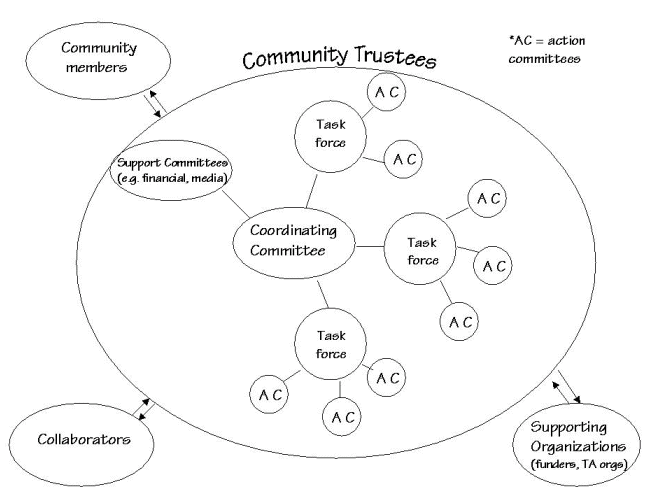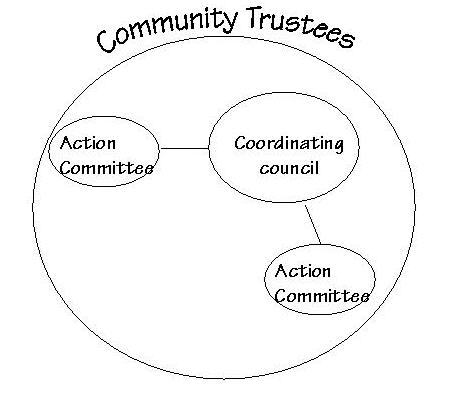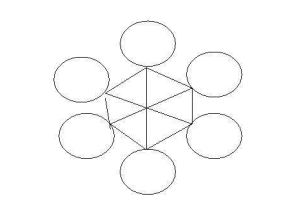

The Tool Box needs your help
to remain available.
Your contribution can help change lives.
Donate now.

Seeking supports for evaluation?
Learn more.
| Learn how to develop a framework that gives members clear guidelines on building organizational structure, and keeping the organization functional. |

By structure, we mean the framework around which the group is organized, the underpinnings which keep the coalition functioning. It's the operating manual that tells members how the organization is put together and how it works. More specifically, structure describes how members are accepted, how leadership is chosen, and how decisions are made.
It is important to deal with structure early in the organization's development. Structural development can occur in proportion to other work the organization is doing, so that it does not crowd out that work. And it can occur in parallel with, at the same time as, your organization's growing accomplishments, so they take place in tandem, side by side. This means that you should think about structure from the beginning of your organization's life. As your group grows and changes, so should your thinking on the group's structure.
While the need for structure is clear, the best structure for a particular coalition is harder to determine. The best structure for any organization will depend upon who its members are, what the setting is, and how far the organization has come in its development.
Regardless of what type of structure your organization decides upon, three elements will always be there. They are inherent in the very idea of an organizational structure.
Governance
The first element of structure is governance - some person or group has to make the decisions within the organization.
Rules by which the organization operates
Another important part of structure is having rules by which the organization operates. Many of these rules may be explicitly stated, while others may be implicit and unstated, though not necessarily any less powerful.
Distribution of work
Inherent in any organizational structure also is a distribution of work. The distribution can be formal or informal, temporary or enduring, but every organization will have some type of division of labor.
There are four tasks that are key to any group:
Every group is different, and so each will have slightly different terms for the roles individuals play in their organization, but below are some common terms, along with definitions and their typical functions.
For example, from the director of a coalition to reduce violence in a medium-sized city: "Currently, we have three operational task forces. Members of each have an ongoing dialogue with members of the coordinating council, and also with their action committees. The oldest was formed with the goal of eliminating domestic violence about fifteen years ago, when a local woman was killed by her husband. Then, after several outbreaks of violence in the schools a few years back, our group offered to help, and a second task force sprung up around reducing youth violence. We've just started a third, with the goal of increasing gun safety.
"All of it is interrelated, and all of it applies to our mission of increasing the safety of residents of South Haven, as well as that of our visitors. But each task force is contributing to that mission in vastly different ways, with different objectives, and using different strategies. 'Cause, you know, the strategies you use to stop a ninth grader from bringing a gun to school just aren't the same as the ones you use to stop a 40-year-old man on unemployment from beating his wife."
Although this list is pretty extensive, your organization may only use two or three of the above mentioned roles, especially at the beginning. It's not uncommon for a group to start with a steering committee, ask others to serve as board members, and then recruit volunteers who will serve as members of action committees. In this broad spectrum of possibilities, consider: Where does your organization fit in? Where do you want to be?
So how can all of these pieces be put together? Again, the form a community group takes should be based on what it does, and not the other way around. The structures given are simply meant to serve as examples that have been found to be effective for some community-based organizations; they can and should be adapted and modified for your own group's purposes.
Example - The Ste. Genevieve's Children's Coalition
The Ste. Genevieve's Children's Coalition is a relatively large community-based group. They have a coordinating council, a media committee, and three task forces, dealing with adolescent pregnancy, immunization, and child hunger. Each of the task forces has action committees as well. For example, the adolescent pregnancy reduction task force has a schools committee that focuses on keeping teen parents in school and modifying the human sexuality curriculum. A health organizations committee focuses on increasing access and use of the youth clinic. The media committee works to keep children's issues in the news, and includes professionals from the local television stations, radio stations, newspaper, and a marketing professional. The coordinating council is composed of the executive director, her assistant, the media committee chair, and the chairs of each of the three task forces. A board of directors has been invaluable in helping keep the coalition financially viable.
In diagram form, a complex organization might look like this:

And in diagram form:

As smaller size means fewer people, these groups are usually less complex, as they have less need for a formal hierarchy and instead have governance that is consensus-based. A diagram of such a small group might look something like this, with each of the circles representing an individual member:

First, decide upon the formality your organization will have. The following table, adapted from The Spirit of Coalition Building can help you make this first decision.
| Conditions favoring more or less formality in organizational structures | ||
| Condition | A looser, less formal, less rule bound structure would be favored when. | A tighter, more formal, more rule-bound structure would be favored when. |
| Stage of organization development | The organization is just starting | The organization is in later stages of development |
| Prior relationships among members | Many such relationships already exist | Few such relationships already exist |
| Prior member experience in working together | Many such experiences have occurred | Few such experiences have occurred |
| Member motivation to be part of the organization | Motivation is high | Motivation is low |
| Number of organization tasks or issues (broadness of purpose) | There is a single task or issue | There are multiple tasks or issues |
| Organization size | The organization is small | The organization is large |
| Organization leadership | The leadership is experienced | The leadership is inexperienced |
| Urgency for action | There is no particular urgency to take action now | There is strong urgency to take action now |
Organizational structure is something that is best decided upon internally, through a process of critical thinking and discussion by members of the group.
In your discussions, your answers to the following list of questions may guide your decisions.
Structure is what ensures that your organization will function smoothly and as you intended. You should think about structure early in the development of your organization, but be aware that the type that fits best may change as your organization grows.